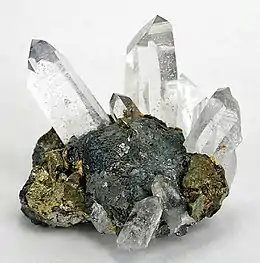Stannite
Stannite is a mineral, a sulfide of copper, iron, and tin, in the category of thiostannates.
| Stannite | |
|---|---|
 | |
| General | |
| Category | Sulfide mineral |
| Formula (repeating unit) | Cu2FeSnS4 |
| IMA symbol | Stn[1] |
| Strunz classification | 2.CB.15a |
| Crystal system | Tetragonal |
| Crystal class | Scalenohedral (42m) H-M symbol: (4 2m) |
| Space group | I42m |
| Unit cell | a = 5.4432, c = 10.7299 [Å]; Z = 2 |
| Identification | |
| Color | Steel-gray to iron-black, may tarnish blue |
| Crystal habit | Rarely as pseudo-octahedral crystals also massive, granular, and disseminated |
| Twinning | Penetration twins on {102} |
| Cleavage | Indistinct on {110} and {001} |
| Fracture | Uneven |
| Mohs scale hardness | 4 |
| Luster | Metallic |
| Streak | Black |
| Diaphaneity | Opaque |
| Specific gravity | 4.3 - 4.5 |
| References | [2][3][4] |
Background
The chemical formula Cu2FeSnS4. Zinc commonly occurs with the iron and trace germanium may be present.[4] Stannite is used as an ore of tin, consisting of approximately 28% tin, 13% iron, 30% copper, 30% sulfur by mass. It is found in tin-bearing, hydrothermal vein deposits occurring with chalcopyrite, sphalerite, tetrahedrite, arsenopyrite, pyrite, cassiterite, and wolframite.[2]
It is also known as bell metal ore as tin is an important constituent of bell-metal. It is thought the exploitation of tin deposits in Cornwall led to an expansion in bell founding.
The name comes from the Latin for tin: stannum. It was first described in 1797 for an occurrence in Wheal Rock, St. Agnes, Cornwall, England.[4]
See also
References
- Warr, L.N. (2021). "IMA–CNMNC approved mineral symbols". Mineralogical Magazine. 85 (3): 291–320. doi:10.1180/mgm.2021.43. S2CID 235729616.
- "Stannite" (PDF). Handbook of Mineralogy.
- "Stannite". Webmineral data.
- "Stannite". Mindat.org.